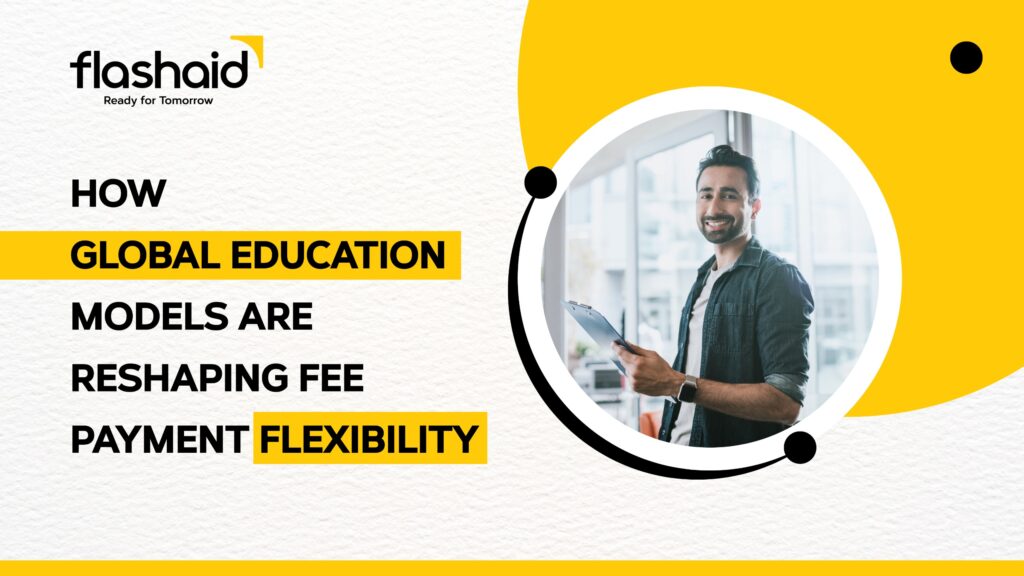When we talk about payment flexibility at a global level across schools, countries such as the U.S. and Singapore are way ahead & technologically advanced. Their payment systems are about flexibility and managing real-life situations. It’s no longer about staying rigid or relying on traditional ways to manage fee collection.
Similarly, institutions have to rebuild new ecosystems where students and learning thrive. They shouldn’t be dependent on short-term financial setbacks.
At FlashAid, we’re on a mission to help Indian schools embrace this shift – offering a fee payment model that’s EMI-free, stress-free, and dropout-proof. In this blog, we’ll explore how global models are changing the game and how your school should be the next.
The U.S. Education Model: Income Share Agreements (ISAs)
Many U.S.-based bootcamps and institutes don’t need students to pay anything upfront. Rather, they repay a small percentage from their income, once they’re employed.
| Pros | Cons |
| Reduces upfront burden | Complex to administer |
| Aligns payment with outcome | Risk of over-commitment if income remains low |
| Encourages institutions to focus on employability | Often used only in higher education |
- Our Takeaway:
Implementing something as complex as ISAs can be a challenge in India. But, the underlying principle is worth taking inspiration from – Institutions must tie or associate payment with ability rather than pressure.
The Singapore Education Model: Fee Staggering & Subsidies
Public schools in Singapore have given these flexibilities to the parents –
- Option to stagger tuition payments monthly
- Avail means-tested subsidies to ease the financial burden.
| Features | Impact |
| Monthly/quarterly fee schedules | Reduced dropout rates |
| Need-based assistance | Higher enrollment from lower-income families |
- Our Takeaway:
The Singapore model is an identical replica of what FlashAid’s EMI-free structure is all about – offering flexibility and providing relief to parents without affecting a child’s learning journey.
The UK Education Model: Government-Backed Tuition Loans
The UK provides interest-controlled, long-term student loans that are to be repaid only when income crosses a certain threshold.
| What Works | What Doesn’t |
| Financial predictability for families | Requires a strong policy infrastructure |
| Widespread access | Debt-averse cultures may still resist loans |
- Our Takeaway:
There’s merit in repayment deferral during crisis periods. It gives parents breathing space and an opportunity to plan their future. This is a model that FlashAid also incorporates through its protective fee coverage.
Why Indian Institutions Must Move from Traditional Fee Management Models
The above global education systems are an example of how the fee management system can be student- and parent-friendly. It’s time that Indian schools too should move away from fixed-fee, fixed-date payment structure. This traditional setup ignores the reality of job loss, medical emergencies, or seasonal income cycles (especially in semi-urban/rural contexts).
| Common Challenges | Impact on Students |
| Missed payment deadlines | Denied access to classes or exams |
| One-time annual billing | High upfront burden on families |
| Lack of empathy from systems | Emotional stress, dropout risk |
How Flashaid Can Help
FlashAid is on a mission to localise global best practices & transform the education ecosystem. We’re against complex loan applications, high & unfair interest rates, and penalizing defaulters
| Feature | Benefit |
| Zero-EMI Recovery | Parents don’t repay during hardship months |
| School Gets 100% Fees On Time | Uninterrupted cash flow for the institution |
| No Credit Score Dependency | Ensures inclusion for all family types |
| Built-in Safeguards | Prevents misuse, maintains accountability |
The biggest difference in the traditional fee payment ecosystem and the one that FlashAid promotes is that we protect the learner through timely intervention rather than react to missed fees with penalties.
| Old Model | FlashAid Model |
| Fee reminders → penalties | Risk flagging → coverage activation |
| Suspension after non-payment | Continued access with dignity |
| Manual case-by-case resolution | AI-led protection across student base |
Who Benefits the Most from Flashaid’s Fee Payment Models?
- Tier II & III city schools where seasonal income tend to affect the payment cycles
- Private K-12 schools that are tired of seeing dropouts
- Progressive, modernised institutions that want to offer parent-friendly, flexible policies
Are You Ahead of the Narrative? Or Left Behind?
By taking inspiration from the global models and implementing them in India, schools can build financial ecosystems that protect an individual’s potential. The question educators must ask themselves now is, “Where does my school stand?” & “What’s the way forward?” Institutions cannot be stuck with rigid, one-size-fits-all fee payment cycles.
Our fee-protection model is a step forward in that direction. At Flashaid, we believe it’s time to match innovation in pedagogy with innovation in payments. One that ensures education never pauses when life does!
Latest News
